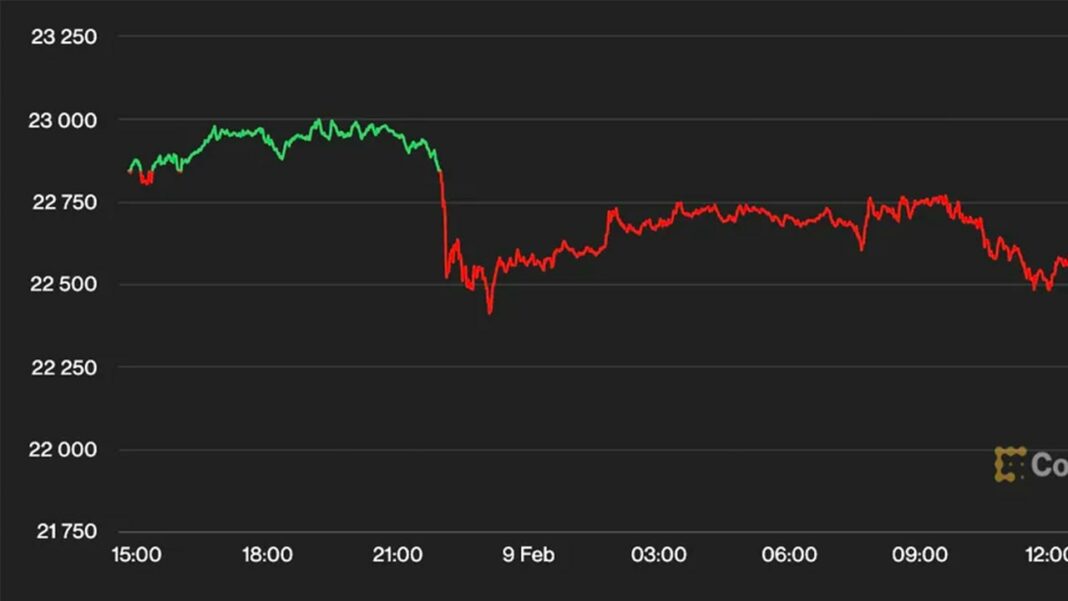Bitcoin dipped below $22,000 Thursday and was recently down nearly 4% over the past 24 hours amid a wider market decline that largely followed news that crypto exchange giant Kraken had agreed to shut its cryptocurrency staking operations to settle charges with the U.S. Securities and Exchange Commission (SEC).
The SEC said later Kraken will “immediately” end its crypto staking-as-a-service platform for U.S. customers and pay $30 million to settle SEC charges it offered unregistered securities.
Bitcoin was recently trading at $21,900. Ether (ETH), the second-largest cryptocurrency, followed BTC’s trend, recently trading down 4.3% to $1,569.
Crypto-related stocks also struggled with Coinbase recently falling 14% during Thursday’s midday trading hours, bitcoin miner Marathon Digital Holdings (MARA) dropping 13%, MicroStrategy (MSTR), a major bitcoin acquirer, down 10%.
The Kraken news followed less than a day after Coinbase CEO Brian Armstrong tweeted his crypto exchange company had heard “rumors” the Securities and Exchange Commission (SEC) wanted” to get rid of crypto staking in the U.S. for retail customers. Armstrong’s tweet prompted a slow late Wednesday-early Thursday decline that sent BTC from its previous support just below $23,000 to about $22,500. A number of analysts have been concerned about this possible development.
“It remains to be seen if these rumors are true, but what is clear is it would be a huge mistake from a U.S. perspective, as it would result in the rest of the world getting ahead in the important crypto and blockchain technology revolution,” Marcus Sotiriou, market analyst at digital asset broker GlobalBlock, wrote in an emailed comment.
Several believe BTC will retreat to $20,000 support in the near future as investors also fret over stubbornly strong jobs data and an extended continuation of hawkish U.S. monetary policy that will hamstring economic growth. But others say the current lull will be temporary and segue into another price surge, similar to trends in earlier years as markets emerged from other bear markets.
“What we are experiencing now seems more similar to the up and then sideways market activity that pretty much defined all of 2019,” which followed a severe price crash, Emurgo Managing Director Vineeth Bhuvanagiri wrote in a note to CoinDesk. Bhuvanagiri wrote that markets had entered “not only a recovery but an accumulation phase” that ultimately helped feed the 2020 bull run.
“I think we’re more likely in a 2019 scenario than an actual bull market,” he added.
Mauricio Di Bartolomeo, co-founder of crypto lending platform Ledn, said in an interview with CoinDesk that while short liquidations typically fuel price increases, a recent absence of BTC short liquidations suggested there “might be more sideway trading left.”
Data from crypto data platform Coinglass showed that investors had liquidated some $90 million in BTC long positions compared to around $42 million in BTC short positions over the past seven days.
“There’s modest leverage being taken both to the downside and the upside,” Bartolomeo said. “Typically what creates those violent moves is leveraged. So right now I think the setup is just trading sideways for the near term.”
BTC plummeted about 60% in 2022 but regained lost ground during a triumphant January. Recent market indicators such as “movement of large amounts of BTC from centralized exchanges to self-custodial wallets,” and “the growth of daily active addresses and transactions” suggest “a potential market bottom” and “a persistence of long-term investor confidence,” according to Messari’s latest quarterly report on bitcoin.
“Although the hype surrounding bitcoin has diminished, the network has historically experienced a resurgence in popularity after periods of doubt,” Messari’s Sami Kassab and Chris Collar wrote in the report.



















